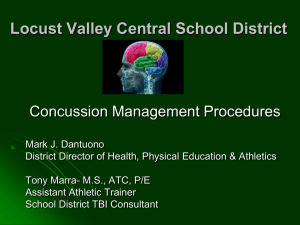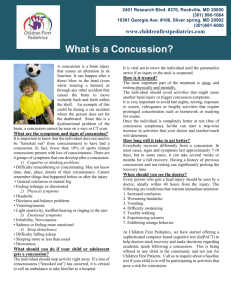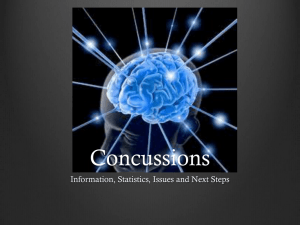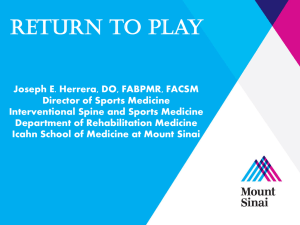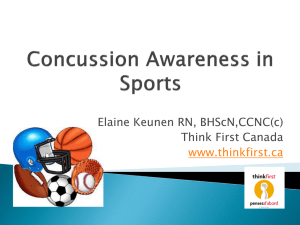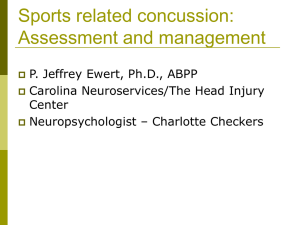Concussion PPT presentation - Seafair Minor Hockey Association
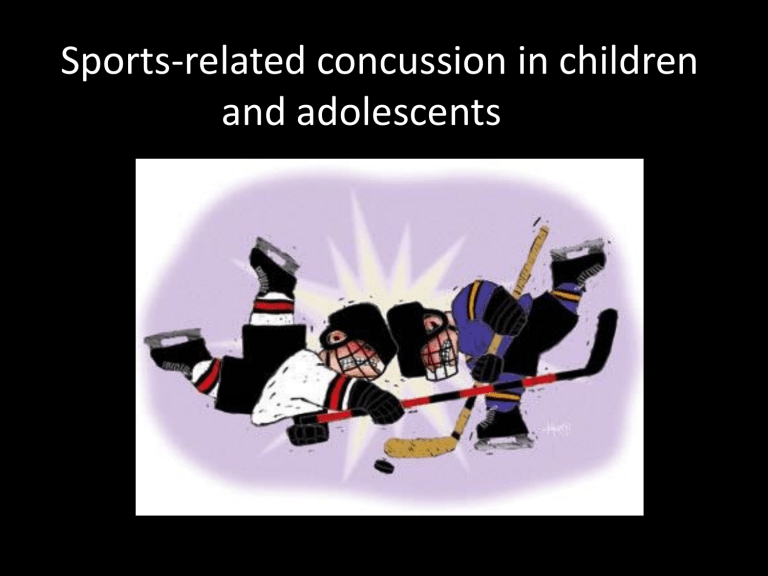
Sports-related concussion in children and adolescents
AGENDA: CONCUSSION MANAGEMENT
UPDATE MEETING
SEAFAIR MINOR HOCKEY - NOVEMBER 8 TH ,
2013
• Introduction: Medical Panel and Seafair Background on
Baseline Testing and Concussion Management (Cody Kusch)
• Background: Concussions and Recent Findings (Naznin Virji-
Babul)
• Medical Evaluation and Recovery Process (Dr. William
Panenka)
• Baseline Testing: SCAT 3 and Axon, update on testing to date, protocol for study, Return to play Protocol (Jonathan Sun)
• Panel: Question and Answer Period (Cody, Bill, Naznin, Dr.
Will Panenka, Jonathan Sun, Dr. Paul Korn)
Background:
• Concussion/mTBI currently considered a ‘silent epidemic’
• Sports activities are a major cause of concussions
• 300,000 sports related concussions occur each year in the United States
What happens to the brain during a concussion?
Shearing in the “wiring” of the brain
Issues for coaches/clinicians/parents:
• Standard neuroimaging tools not sensitive to detect subtle changes in brain structure and function
• Diagnosis and evaluating functional recovery very difficult
Advanced MRI can “see” subtle changes in the wiring of the brain
No concussion Concussed athlete
fMRI measures “thinking”
Brain activity is more “scattered”
Control Concussed
Signs and Symptoms of Concussion
• By an observer – not only LOC!
– Dazed or stunned, confused about assignment
– Forgets instruction, game score, opponent
– Off balance, answers slowly, loses consciousness
– Mood, behavior or personality changes.
– Amnesia for events around injury
• By the athlete –
– Headache, nausea or vomiting
– Balance problems or dizziness
– Double or blurry vision
– Sensitivity to light or noise
– Concentration or memory problems, confusion
Recovery From Concussion:
How Long Does it Take?
N=134 High School athletes Collins et al., 2006, Neurosurgery
Concussion Modifiers
McCrory P, et al. Br J Sports Med 2013;47:250–258. doi:10.1136/bjsports-2013-092313
Medical Evaluation
• Individual clinical decision
• A medical assessment including a comprehensive history and detailed neurological examination including a thorough assessment of mental status, cognitive functioning and gait and balance.
• A determination of the clinical status of the patient including whether there has been improvement or deterioration since the time of injury. This may involve seeking additional information from parents, coaches, teammates and eyewitness to the injury.
• A determination of the need for emergent neuroimaging in order to exclude a more severe brain injury involving a structural abnormality
Persistently symptomatic patient
• Persistent symptoms (>10 days) in about 10-15%
• Important to consider other issues
• Should be managed in multidisciplinary manner by healthcare providers experienced in sport concussion
Table from Ontario Neurotrauma mTBI Guidelines, and adapted from Current Treatment Options in Neurology. 2006;8:415-426
Child/teenage athletes
• Consider age specific physical and cognitive rest issues
– school attendance and activities need to be modified
• No return to sport or activity until returned to school successfully
• Symptom resolution may take longer, modifiers apply even more
• More conservative RTP approach recommended:
– Consider extending symptom-free period before starting return to play protocol
– Consider extending length of the graded exertion protocol
• Never return to play same day
Issues in the field
• No “gold” standard for assessment
• Return to play/learn protocols are based on
“expert” opinion not hard evidence
Seafair Study
• Use 2 different assessments to evaluate which one is most sensitive
• Never been done before
Baseline and End of season
Assessments:
• SCAT3
Baseline: 341 players tested to date
• AXON
Baseline: Only 73 completed to date
Concussion Protocol
Suspected Concussion
Coach/Manager pulls player off the ice SCAT3/AXON repeated
Referral to BCCH/Dr. Korn/Dr. Panenka as needed
Dr. ‘Naz’ to screen players for MRI study
Must be within 1 week of concussion
Repeat scan if symptomatic at 6 weeks
Return to play protocol
• 1. No Activity. Complete physical and cognitive rest
• 2. Light aerobic exercise (Walking, swimming or stationary cycling keeping intensity <70% maximum predicted heart rate.
No resistance training
• 3. Sport-specific exercise (Skating drills in ice hockey, running drills in soccer. No head impact activities)
• 4. Non-contact training drills. Progression to more complex training drills, e.g. passing drills in football and ice hockey.
May start progressive resistance training
• 5. Full contact practice following medical clearance, participate in normal training activities
• 6. Normal game play






